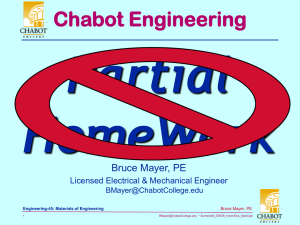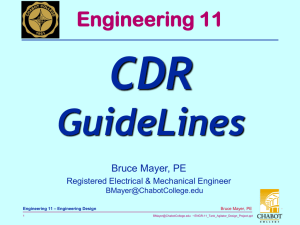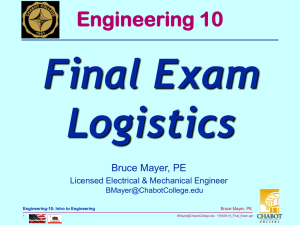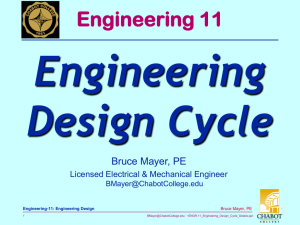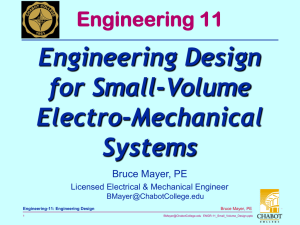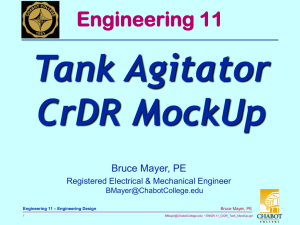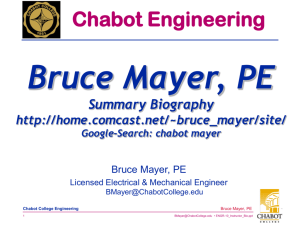X Design for Engineering 11 Bruce Mayer, PE
advertisement
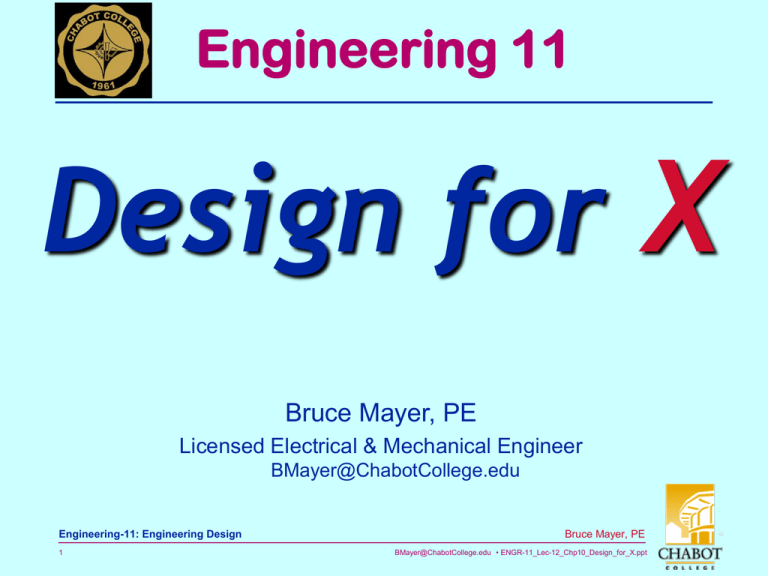
Engineering 11 Design for X Bruce Mayer, PE Licensed Electrical & Mechanical Engineer BMayer@ChabotCollege.edu Engineering-11: Engineering Design 1 Bruce Mayer, PE BMayer@ChabotCollege.edu • ENGR-11_Lec-12_Chp10_Design_for_X.ppt OutLine Design for X Trade-offs in Satisfaction Robust design Failure Modes & Effects Analysis Tolerance design Customer Needs (CN) Engineering-11: Engineering Design 2 Functional Requirements (FR) Design Parameters (DP) Process Variables (PV) Bruce Mayer, PE BMayer@ChabotCollege.edu • ENGR-11_Lec-12_Chp10_Design_for_X.ppt Basic Design Engineering Goals Design Engineering Goals for Product: • “performs as expected” • “works all the time” & “lasts long” • “is easy to maintain” and THAT • no damage occurs to product • no damage or harm to environment • no harm or injury to operator or user Engineering-11: Engineering Design 3 Bruce Mayer, PE BMayer@ChabotCollege.edu • ENGR-11_Lec-12_Chp10_Design_for_X.ppt Design for X (DfX) During design, we often focus on the final product, and not its manufacture. The Design For X (DfX) philosophy suggests that a design be continually reviewed from the start to the end to find ways to improve production and other non-functional aspects Advantages of DfX techniques include • • • • • • shorter production times fewer production steps smaller parts inventory more standardized parts simpler designs that are more likely to be robust they can help when expertise is not available, or as a way to re-examine traditional designs • proven to be very successful over decades of application Engineering-11: Engineering Design 4 Bruce Mayer, PE BMayer@ChabotCollege.edu • ENGR-11_Lec-12_Chp10_Design_for_X.ppt The “X” in DfX Engineering-11: Engineering Design 5 Bruce Mayer, PE BMayer@ChabotCollege.edu • ENGR-11_Lec-12_Chp10_Design_for_X.ppt Design for Robustness Methods to reduce the sensitivity of product performance to variations such as: • manufacturing (materials & processes) • wear • operating environment Currently used methods • Taguchi Method • Probabilistic optimal design (Monte Carlo) Both Taguchi and Monte Carlo methods use statistics and probability theory Engineering-11: Engineering Design 6 Bruce Mayer, PE BMayer@ChabotCollege.edu • ENGR-11_Lec-12_Chp10_Design_for_X.ppt Failure Modes & Effects Analysis The FMEA Method seeks to systematically identify and correct potential product or process deficiencies before they occur The Process • Identify EVERY Way in Which Product Can FAIL; i.e., determine the Failure MODES • Analyze the CONSEQUENCES of Every Failure; i.e., determine the EFFECTS Engineering-11: Engineering Design 7 Bruce Mayer, PE BMayer@ChabotCollege.edu • ENGR-11_Lec-12_Chp10_Design_for_X.ppt Failure Modes & Effects Analysis After Completion of the FMEA Work to REDUCE • The NUMBER of Failure MODES • The SEVERITY of the EFFECTS Prioritize Risk Reduction using “Risk Priority No.” Engineering-11: Engineering Design 8 Bruce Mayer, PE BMayer@ChabotCollege.edu • ENGR-11_Lec-12_Chp10_Design_for_X.ppt FMEA Example Log Splitter FMEA considers Both DESIGN and MANUFACTURING Deficiencies Example Hydraulic Log Splitter • Hydraulic hose, on a home-use log splitter, begins to leak. • The leak reduces the pressure to the piston/ram resulting in poor splitting. • The leak drips oil on ground, creating a mess, costly too! • Upon examination, a weak spot is found on hose due to poor manufacturing! Engineering-11: Engineering Design 9 Bruce Mayer, PE BMayer@ChabotCollege.edu • ENGR-11_Lec-12_Chp10_Design_for_X.ppt FMEA Main Concepts Failure Mode: the “way” a part fails to perform • e.g. failure mode: hose leaks Effect: adverse consequence of failure mode • e.g. hose leak results in oil spills, refill costs • Effects can be severe or hardly noticeable. Cause: why it fails (or may fail) • • e.g. poor hose manufacturing, improper pressure Causes occur with some likelihood or probability Dectectability: the ability to discover the cause before the part is shipped from the factory. • e.g. conduct a pressure test to detect leaks? Engineering-11: Engineering Design 10 Bruce Mayer, PE BMayer@ChabotCollege.edu • ENGR-11_Lec-12_Chp10_Design_for_X.ppt FMEA Risk Metric RPN Determine a rating for each mode of failure …. using a “risk priority number” (RPN) RPN = [Severity rating] x [Occurrence rating] x [Detection rating] RPN = (S)•(O)•(D) RPN will range from 1 to 1000 • Large RPN “bad” • Small RPN “good” Engineering-11: Engineering Design 11 Bruce Mayer, PE BMayer@ChabotCollege.edu • ENGR-11_Lec-12_Chp10_Design_for_X.ppt RPN Calculation Step 1: determine the failure modes • From: – Engineering design specifications – Function decomposition diagrams – functions ---- matter, energy, signal – HoQ – free body diagrams – force flow diagrams – process flow diagrams – configuration sketches / drawings Engineering-11: Engineering Design 12 Bruce Mayer, PE BMayer@ChabotCollege.edu • ENGR-11_Lec-12_Chp10_Design_for_X.ppt RPN Calculation Step 2: determine potential effects of each failure mode Step 3: determine a severity (S) rating for each effect from the Severity rating table. Step 4: determine an occurrence (O) rating for each cause from the Occurrence rating table. Step 5: determine a detection (D) rating for each cause from the Detection rating table Engineering-11: Engineering Design 13 Bruce Mayer, PE BMayer@ChabotCollege.edu • ENGR-11_Lec-12_Chp10_Design_for_X.ppt Severity Rating Criteria Severity (S) Rating 10 9 8 7 6 5 4 3 2 1 Type of effects Causes injury to people, property and or the environment Causes damage to product, property or Extremely Harmful environment Very Harmful Causes damage to product Major degradation of function Harmful Moderate Causes partial malfunction of product Significant Performance loss causes customer complaints Loss of function is annoying, cannot be overcome Annoying Minor Some loss of performance, but can be overcome Insignificant Very little function degradation No noticeable effects in function or harm to others None Catastrophic Engineering-11: Engineering Design 14 Description Bruce Mayer, PE BMayer@ChabotCollege.edu • ENGR-11_Lec-12_Chp10_Design_for_X.ppt Occurrence Rating Criteria Occurence (O) Rating 10 9 8 7 6 5 4 3 2 1 Likelihood Expected Very likely Probable Occasional More plausible Plausible Remote Unlikely Very unlikely Improbable Engineering-11: Engineering Design 15 Description > One per day >30 % 30 % (3 per 10) 5 % (5 per 100) 1 % ( 1 per 100) 0.3 % (3 per 1,000) One per week One per month One per three months 5 0.006 % (6 per 10 ) One per year 7 0.00006 % (6 per 10 ) One per three years 9 < 2 per 10 events > five years per failure Bruce Mayer, PE BMayer@ChabotCollege.edu • ENGR-11_Lec-12_Chp10_Design_for_X.ppt Detection Rating Criteria Detection (D) Rating 10 9 8 7 6 5 4 3 2 1 Detectability Impossible Very rare Rare Possible Quite possible Somewhat likely Likely Quite likely Almost certain Certain Engineering-11: Engineering Design 16 Description Impossible to detect, or no inspection Some chance of detecting, or 50% inspection Quite likely to detect, or 75% inspection Will be detected, or 100% inspection Bruce Mayer, PE BMayer@ChabotCollege.edu • ENGR-11_Lec-12_Chp10_Design_for_X.ppt RPN Calculation & Reduction Step 6: calculate the risk priority number for each effect Step 7: prioritize or rank the failure modes for action Step 8: take action to eliminate the failure mode or reduce its severity Step 9: recalculate the risk priority number as failure modes are reduced or eliminated Engineering-11: Engineering Design 17 Bruce Mayer, PE BMayer@ChabotCollege.edu • ENGR-11_Lec-12_Chp10_Design_for_X.ppt RPN Calculation Summary RPN Calculations are Usually Tabulated or put in a SpreadSheet Severity (S) Failure mode S Effects Rating Engineering-11: Engineering Design 18 Occurrence (O) Causes Detection (D) O controls Rating tests D Recommended Rating RPN Action Bruce Mayer, PE BMayer@ChabotCollege.edu • ENGR-11_Lec-12_Chp10_Design_for_X.ppt RPN Example Hose Failure Log-Splitter RPN & Remediation Severity (S) Failure mode hydraulic hose leaks Effects S Rating Occurrence (O) Causes poor log 7 splitting (harmful) weak spot O Rating 7 (1%) Detection (D) controls tests D Recommended Rating RPN Action 10 490 none oil mess costs to refill Engineering-11: Engineering Design 19 Bruce Mayer, PE BMayer@ChabotCollege.edu • ENGR-11_Lec-12_Chp10_Design_for_X.ppt implement pressure test Design for Safety Issues Injury Hazards Conditional Circumstances Legal Responsibilities Guidelines for Safe Products/Systems Safety Hierarchy Safe Design Principles Engineering-11: Engineering Design 20 Bruce Mayer, PE BMayer@ChabotCollege.edu • ENGR-11_Lec-12_Chp10_Design_for_X.ppt Define Safe Product/System No injury to user, (products liability) No injury to consumer/society No injury to production worker No damage to personal property No damage to real property or the environment Engineering-11: Engineering Design 21 Bruce Mayer, PE BMayer@ChabotCollege.edu • ENGR-11_Lec-12_Chp10_Design_for_X.ppt Hazards Hazard ≡ a source of danger which has the potential to injure people or damage property or the environment Partial Hazard List • • • • • • Entrapment – pinch, crush Contact – heat, sharp edges, electric Impact – hammer, robot arm Ejection – grinder sparks, saw dust Entanglement – hair, clothing Noise & Vibration – hearing loss, HAVS Engineering-11: Engineering Design 22 Bruce Mayer, PE BMayer@ChabotCollege.edu • ENGR-11_Lec-12_Chp10_Design_for_X.ppt Conditional Circumstances hazard is inherent during normal use hazard originates from a component failure hazard caused by user misuse hazard exists during normal maintenance hazard created by improper maintenance hazard stems from lack of maintenance Engineering-11: Engineering Design 23 Bruce Mayer, PE BMayer@ChabotCollege.edu • ENGR-11_Lec-12_Chp10_Design_for_X.ppt Product Legal-Liability Plaintiff’s attorney will try to prove that the company or its employees failed to: • perform “appropriate analyses.” • comply with published standards. • make use of state-of-the-art technology, due to ignorance. • • • • include reasonable safety features or devices. take into account how the user might misuse the product. consider hidden dangers that might surprise the user. consider variations in materials, mfg processes, or effects of wear. • carry out appropriate testing, or interpret results correctly. Engineering-11: Engineering Design 24 Bruce Mayer, PE BMayer@ChabotCollege.edu • ENGR-11_Lec-12_Chp10_Design_for_X.ppt Guidelines for Safe Products 1. 2. 3. 4. Perform appropriate analyses Comply with published standards Use state-of-the-art technology Include reasonable safety features or devices 5. Take into account how the user might misuse the product 6. Consider hidden dangers that might surprise the user Engineering-11: Engineering Design 25 Bruce Mayer, PE BMayer@ChabotCollege.edu • ENGR-11_Lec-12_Chp10_Design_for_X.ppt Guidelines for Safe Products 7. Consider variations in materials or manufacturing processes, or effects of wear 8. Carry out appropriate testing and interpret results correctly 9. Provide adequate warnings 10. Implement superior quality control 11. Document everything Engineering-11: Engineering Design 26 Bruce Mayer, PE BMayer@ChabotCollege.edu • ENGR-11_Lec-12_Chp10_Design_for_X.ppt Safety Hierarchy Method 1. Eliminate the hazard - ProActive approach, “design-out” the hazard (eliminate any moving parts, hot or sharp surfaces) 2. Protect against the hazard with passive approach, (machine guards, seat belts) 3. Warn against the hazard - weak remedy (warning labels, alarms) 4. Provide Training - Provide and require operating training. 5. Provide Personal Protection - LEAST effective, (safety glasses, gloves, shoes) Engineering-11: Engineering Design 27 Bruce Mayer, PE BMayer@ChabotCollege.edu • ENGR-11_Lec-12_Chp10_Design_for_X.ppt Safe-Design Principles Safe-Life Good • entire predicted useful life without malfunction. • designers to identify all operating conditions, misuses and abuses • design appropriate maintenance and repair schedules. Fail-Safe Better • upon failure of a component, product/system SHUTS DOWN safely, • critical functions are sometimes still performed – e.g. boiler feed-water valve failing in the open position Redundant design Best (but EXPENSIVE) • additional product components or systems are designed to take over the principle function of the failed component or system. – e.g., multi-engine airplanes, emergency brakes, BackUp pumps in nuclear PowerPlants Engineering-11: Engineering Design 28 Bruce Mayer, PE BMayer@ChabotCollege.edu • ENGR-11_Lec-12_Chp10_Design_for_X.ppt All Done for Today Environmental Tolerance Zone The ETZ is the Limits of SURVIVAL • Well Beyond the Comfort Zone Engineering-11: Engineering Design 29 Bruce Mayer, PE BMayer@ChabotCollege.edu • ENGR-11_Lec-12_Chp10_Design_for_X.ppt Engineering 11 Appendix Bruce Mayer, PE Registered Electrical & Mechanical Engineer BMayer@ChabotCollege.edu Engineering-11: Engineering Design 30 Bruce Mayer, PE BMayer@ChabotCollege.edu • ENGR-11_Lec-12_Chp10_Design_for_X.ppt Method 6-3-5 (Brain-Writing) The traditional brainstorming relies on verbal communications. • Idea generation may be dominated by a small number of aggressive members. Guidelines for 6-3-5 method Team members are arranged around a circular table to provide continuity. Six (6) members are ideal. Each member sketches three (3) ideas for the product configuration or functions. Sketches should be the focus of this activity. The top five product functionswith respect to the customer needs are considered. Engineering-11: Engineering Design 31 Bruce Mayer, PE BMayer@ChabotCollege.edu • ENGR-11_Lec-12_Chp10_Design_for_X.ppt Engineering-11: Engineering Design 32 Bruce Mayer, PE BMayer@ChabotCollege.edu • ENGR-11_Lec-12_Chp10_Design_for_X.ppt
